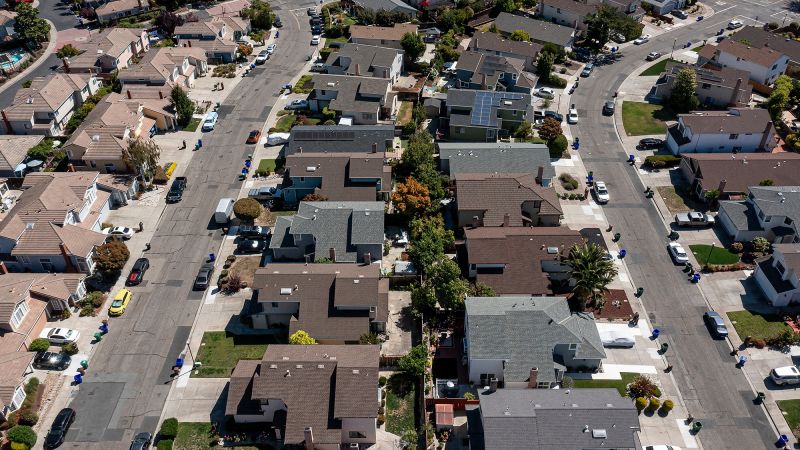Mortgage rates tumbled this week in the biggest one-week drop since last November. It’s the second straight week that rates have fallen, after rising for seven consecutive weeks.
The 30-year fixed-rate mortgage fell to an average of 7.50% in the week ending November 9, down from 7.76% the week before, according to data from Freddie Mac released Thursday.
A year ago, the average 30-year fixed-rate reached 7.08%, its highest level in 2022. The following week, rates dropped by 47 basis points. This week saw a drop of 26 basis points from last week.
“As Treasury yields decline, the 30-year fixed-rate mortgage dropped a quarter of a percent, the largest one-week decrease since last November,” said Sam Khater, Freddie Mac’s chief economist.
“Incoming data show that household debt continues to rise, primarily due to mortgage, credit card and student loan balances,” he said. “Many consumers are feeling strained by the high cost of living, so unless mortgage rates decrease significantly, the housing market will remain stagnant.”
The average mortgage rate is based on mortgage applications that Freddie Mac receives from thousands of lenders across the country. The survey includes only borrowers who put 20% down and have excellent credit. A current buyer’s rate may be different.
Homebuyers have been shellshocked by surging rates, which have sent home loan applications and home sales down sharply. Sales hit a 13-year low in September as buyers paused their home search, waiting for more inventory and lower mortgage rates.
But as mortgage rates dipped last week, there was a 2.5% increase in all applications for loans from a week ago, according to the Mortgage Bankers Association. Applications for a mortgage to purchase a home went up by 3%.
“Applications for both purchase and refinance loans were up over the week but remained at low levels,” said Joel Kan, MBA’s vice president and deputy chief economist. “The purchase index is still more than 20% behind last year’s pace, as many homebuyers remain on the sidelines until more for-sale inventory becomes available.”
The Federal Reserve’s decision at last week’s monetary policy meeting to keep interest rates where they were was good news for homebuyers struggling with sky-high mortgage rates, but the option for an additional Fed rate hike is still on the table.
“More economic indicators are needed to determine whether the current policy is ‘restrictive enough’ to bring inflation back to the [Fed’s] 2% target,” said Jiayi Xu, an economist at Realtor.com.
While the Fed does not set the interest rates that borrowers pay on mortgages directly, its actions influence them. Mortgage rates tend to track the yield on 10-year US Treasuries, which move based on a combination of anticipation about the Fed’s actions, what the Fed actually ends up doing and investors’ reactions. When Treasury yields go up, so do mortgage rates; when they go down, mortgage rates tend to follow.
Meanwhile, Xu said, the October jobs report, which revealed moderate job growth and reduced wage pressures, might boost confidence among policymakers that the economy will continue to ease without the need for more Fed rate hikes in the coming months. The Fed’s last rate-setting meeting of the year is scheduled for December 12-13.
“As the possibility of a rate hike remains on the table, investors are likely to exercise caution in their positioning, and the expectations for [mortgage] rates to stay steady to slightly higher remains,” said Xu.
Homebuyers are getting a little break in rates just as unaffordability reaches new heights.
While the median price of a home in October was about the same as last year, according to Realtor.com, mortgage rates that have been over 7% since mid-August have resulted in a significant increase in the cost of financing a typical home purchase.
The monthly cost to buy a home has risen by over $166. That’s a 7.4% increase compared to the previous year and a new record in the year-over-year increase in the cost of buying a home, Realtor.com has found.
But while mortgage rates remain relatively high, the difference between rates now and what they were a year ago has narrowed, said Lisa Sturtevant, chief economist at Bright Multiple Listing Service.
“In many ways, market conditions are similar to what they were last November,” she said. “The difference is that consumers have adjusted their expectations about mortgage rates.”
“Many buyers are pressing on and will act quickly when they see rates dip,” she said. “Other prospective homebuyers will bide their time until after the first of the year, hoping for lower rates and more inventory.”
While rates are expected to come down in 2024, she said, they are not forecast to return to pandemic levels.
“We are in a new era for mortgage rates, where prospective homebuyers can expect rates to settle above 6%,” said Sturtevant.
Read the full article here











Leave a Reply